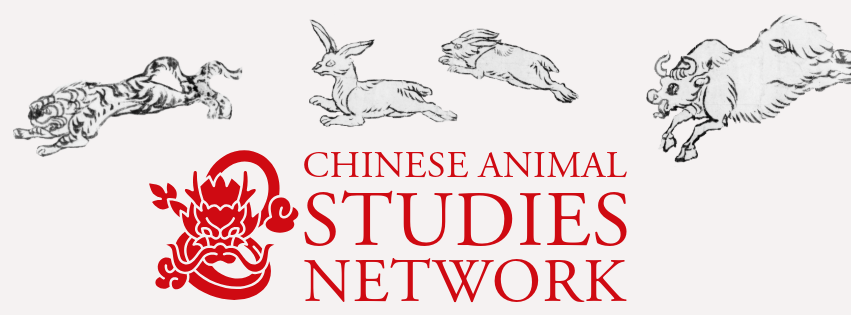
In our first Meet a Grad Student feature, we are thrilled to hear from Shasha Cai at Leeds University about her doctoral research as she finishes writing up her thesis!

Shasha Cai is a Ph.D. candidate in the School of English, University of Leeds. She is mostly interested in Animal Studies in the context of Chinese literature. Currently, Shasha is working on her Ph.D. project, which investigates representations of human-animal interactions in Chinese Ming and Qing literary works. She is also interested in exploring animals through the perspectives of energy humanities and critical plant studies.
Hi Shasha! Thank you for being our first featured graduate student! To start, what first inspired you to include animals in your research?
During my Masters, my research topic was ecocriticism. At that time, I felt the key question was defining humans’ role in the world: are we parental caretakers of the ecosystem or are we simply members of it? Animal Studies was the ideal field in which to explore this, as animals have historically shaped our understanding of human identity. My aim isn’t to reinforce existing definitions of humanity, but rather to critique and redefine (or perhaps abandon) the inflated importance of human identity in relation to the natural world. This might be the reason my Ph.D. project ends with envisioning a post-humanist approach rather than the more popular animal-oriented one.
Your Ph.D. focuses on human-animal interactions in Ming and Qing literature in particular. Could you summarise your thesis topic for us?
My Ph.D. project forges a conversation between Western Animal Studies and Chinese Ming-Qing literary texts. I use Giorgio Agamben’s theory of the “anthropological machine” to bring these two topics together or, more specifically, the Confucian anthropological machine as first proposed by Eske Møllgaard in 2010.1 The logic of Agamben’s “anthropological machine” is that there is a continuous and intentional separation of humans from other animals. In my thesis, I explore this Confucian machine’s mechanisms and its malfunctions through four literary texts from the Ming and Qing dynasties: Journey to the West (1592), Strange Tales from Liaozhai (1766), the trilogy of Sanyan (c. 1621; 1624; 1627), and The Romance of Three Kingdoms (1522).
I start by analysing the Monkey King as a trickster who challenges species boundaries. In Chapter Two, I then explore the liminality of fox spirits which, using the perspective of queer ecologies, queer the species taxonomy. In my third chapter, I situate serpentine power as being especially transformative and unifying, and suggest this power helps to demonstrate Deleuze and Guattari’s idea of “becoming-animal.”2 Finally, I focus on military horses and the idea of interconnectivity and companionship as articulated by Donna Haraway.3 The theoretical concepts in these chapters, along with the animal figures that manifest them, contribute to our understandings of the Confucian anthropological machine and, most importantly, its “exit strategies”.
What an exciting project! Is there anything surprising you’ve come across in your research so far?
What surprises me most comes from Donna Haraway’s Primate Visions.4 Put simply, the scientific knowledge that we humans have constructed about animals is surprisingly subjective. When life science is read as a narrative, its sexist, racist, and, most importantly, speciesist orientations become clear. For example, scholars have shown how scientists have deliberately hidden evidence of queer animal behaviour to uphold heterosexual norms. With this critical view, I find nothing can be taken for granted.
I’m also fascinated by the interdisciplinary nature of Animal Studies, which opens up exciting possibilities across different fields. In my second chapter, I introduced the concept of a liminal species, inspired by the mythical fox spirit. At first, I worried it might remain a myth without practical relevance. Then, a friend with a background in biology introduced me to incredible species like symbiotic lichens and nearly immortal slime moulds! I realised my idea of liminal species could actually help to describe such fascinating organisms. Generally speaking, Animal Studies has encouraged me to stay open-minded. It has sparked new interests, like exploring the powerful agency of plants in shaping the Earth and the astonishing ways fungi live and interact with their environment.
Immortal moulds and fungi sound like a fascinating follow-up project! Is there a resource or theory you’ve found particularly helpful while developing your research?
I know Agamben’s “anthropological machine” may seem like an outdated concept in Animal Studies, as discussions have shifted to what comes after the machine rather than the machine itself. However, as my thesis argues, the concept deserves more attention even in an era where animals seem to have become such well-represented and valid topics of interest. Have we truly abandoned a human-centric approach within animal welfare and animal rights movements? Much of the success of these movements often hinges on whether animals are like humans — a perspective that echoes Agamben’s human-centric anthropological machine. Moreover, are we really living in a time when this machine has ceased to function, and we recognise animals as equal, but different, beings? I believe we should not consider Agamben’s theory as merely a stepping stone to discuss animal rights, welfare, and ethics, but as an effective litmus test revealing whether we have abandoned our claims of human exceptionalism.
Finally, if you could be an animal, what animal would you be and why?
I would want to be a human but in the sense of an animal-human. I find Professor Krithika Srinivasan’s “Re-animalising Wellbeing” to be particularly helpful in explaining this.5 In her insightful article, Srinivasan invites us to rethink human well-being in terms of re-animalising, challenging some of the most foundational pillars of modern human life. I especially agree that reconfiguring human lives requires accepting the vulnerability we share with other animals and recognising our place among the diverse forms of life on Earth. If a good human life is not measured by statistics to indicate progress, humans might be able to live in the moment and appreciate life itself, much like other animals always have.
- Giorgio Agamben, The Open: Man and Animal, trans. by Kevin Attell (Stanford University Press, 2004). Eske Møllgaard, “Confucianism as Anthropological Machine”, Asian Philosophy, 20.2 (2010), 127-140. ↩︎
- Gilles Deleuze and Félix Guattari, “Becoming-Intense, Becoming-Animal, Becoming-Imperceptible…”, in A Thousand Plateaus: Capitalism and Schizophrenia, trans. by Brian Massumi (University of Minnesota Press, 1987). ↩︎
- Donna J. Haraway, The Companion Species Manifesto: Dogs, People, and Significant Otherness (Prickly Paradigm Press, 2003). ↩︎
- Donna J. Haraway, Primate Visions: Gender, Race, and Nature in the World of Modern Science (Routledge, 1990). ↩︎
- Krithika Srinivasan, “Re-animalising Wellbeing: Multispecies Justice after Development”, The Sociological Review Monographs, 70.2 (2022), 352-366. ↩︎


